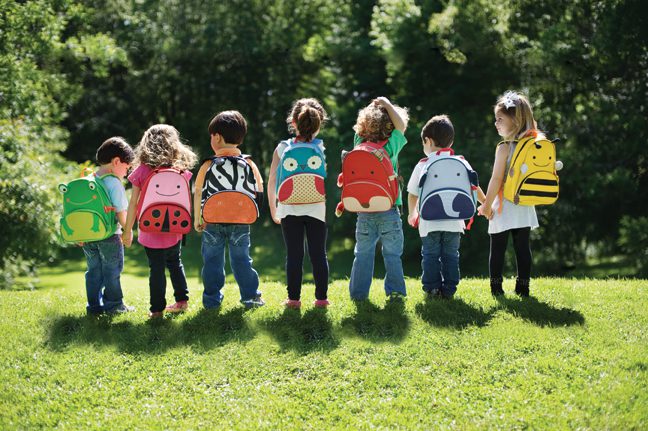Pack it Light, Wear it Right!
As summer comes to a close, focus is beginning to shift onto the upcoming school year and all the excitement that comes with going back to school! For many children, the fun of going and getting new clothes, new school supplies and, you guessed it, that new backpack with the latest and greatest superhero or Disney princess is all part of the excitement! We know that your children’s safety is your biggest concern. Moreover, we teach them how to look both ways before crossing the street and that they have to wear a helmet while riding their bike. Why would we think to teach them how to properly wear a backpack?
What’s the impact on children?
Many of us don’t even consider the risks of a child wearing a poor fitting, heavy backpack to and from school everyday, lifting it up and down upwards of ten times a day for an entire school year. It is estimated that approximately 14,000 kids are treated for backpack related injuries per year. A report conducted by the federal consumer product safety commission calculated that carrying a twelve-pound backpack everyday puts a cumulative load on children’s bodies of approximately 21,600 pounds. Carrying overloaded backpacks zaps children’s energy that is better spent doing school work and participating in sports.
Excessive loads and improper use of backpacks has been linked to an increase in injuries. Neck and back pain, headaches, bad posture, and nerve injury in children and youth are all common ones. As a result, it is suggested that when children and youth are exposed to lugging around overweight backpacks regularly, they may experience muscular fatigue. They may also become susceptible to overuse injuries, especially the younger school aged children whose muscle development has yet to completely develop. It may not be adequate to sustain the unbalanced heavy loads placed on them by poorly worn backpacks.
Along with the British Columbia Chiropractic Association, Harmony Chiropractic & Wellness Clinic advocates the ‘Pack it Light, Wear it Right’ campaign in order to aid in the prevention of such injuries! Furthermore, we believe that education is crucial and have put together some information to help guide parents and students to properly wear their backpacks and prevent future injury.
What parts of a child’s body are affected?
Firstly, I would like to point out some of the areas most affected by improperly wearing heavy backpacks. The biggest areas of concern are your children’s neck, shoulders, lower back, hips and knees. Let’s start off with the neck. Heavy backpacks create a forward trunk lean (rounding of the upper back) which causes a forward head posture with extended neck. This in turn creates neck and shoulder pain and makes it difficult for muscles and ligaments to hold the body up properly. Your children’s shoulders are not meant to hang things on. When a heavy load is put on their shoulders, joints get tight, muscles tighten down and it biomechanics are altered.
The change in your child’s posture from wearing a heavy backpack puts strain on the lower back, hips and knees. Therefore, in order to compensate for the excess weight, your child’s posture will adjust with a forward lean. This can result in lower back pain and muscle tightness. In addition, their hips will become sore as a result of leaning forward to compensate for the backward pull of the backpack. Moreover, knee pain is possible because of the change in posture and is also due to a change in walking pattern.
Here are some helpful tips to ensure your child is correctly wearing a suitable backpack:
Fit & Sizing:
Material:Be sure to choose a backpack that is made for children. They are made of a much more lightweight fabric than backpacks manufactured for adults.
Positioning:A backpack should be worn close to the body, with minimal space between the pack and your child’s back.
Length:The backpack should be the length of your child’s torso, with the bottom sitting no more than 2 inches below the waist.
Extras:We suggest trying to find a suitable backpack, with padded and adjustable shoulder straps, and padded back surface.
Weight:
Distribution:Use backpacks with multiple compartments to help distribute the weight of its contents. Pack the heavier things low, and towards the back, closer to the body.
Ratio:It is recommended that a backpack be no more than 10-15% of your child’s body weight, that being said, younger children should max out at 10%, with older children being able to carry up to 15% of their weight.
| If you Weigh: | You Should only Carry: |
| 50 lbs | 5 lbs |
| 70 lbs | 7 lbs |
| 90 lbs | 14 lbs |
| 110 lbs | 16 lbs |
| 130 lbs | 19 lbs |
| 150 lbs | 22 lbs |
| 170 lbs | 25 lbs |
| 190 lbs | 28 lbs |
*Above Table from the BCCA website.
Extra Support:
Shoulders: Always ensure your child is carrying their backpack over both shoulders so that there isn’t too much stress on one side of the spine.
Waist:Try to find a backpack with a waist strap (preferably a thick one), as children should always use the waist strap to help distribute and stabilize the weight.
Putting it On:We also recommend raising the backpack to a flat surface, at waist height, such as a desk, or table.You are then able to slip on the backpack, one shoulder at a time, without having to bend sideways and pick up the weight.
It is important to help your child form habits to a healthy lifestyle so we are able to reduce the risk of injury and pain.
That’s all for now. Until Next time….




